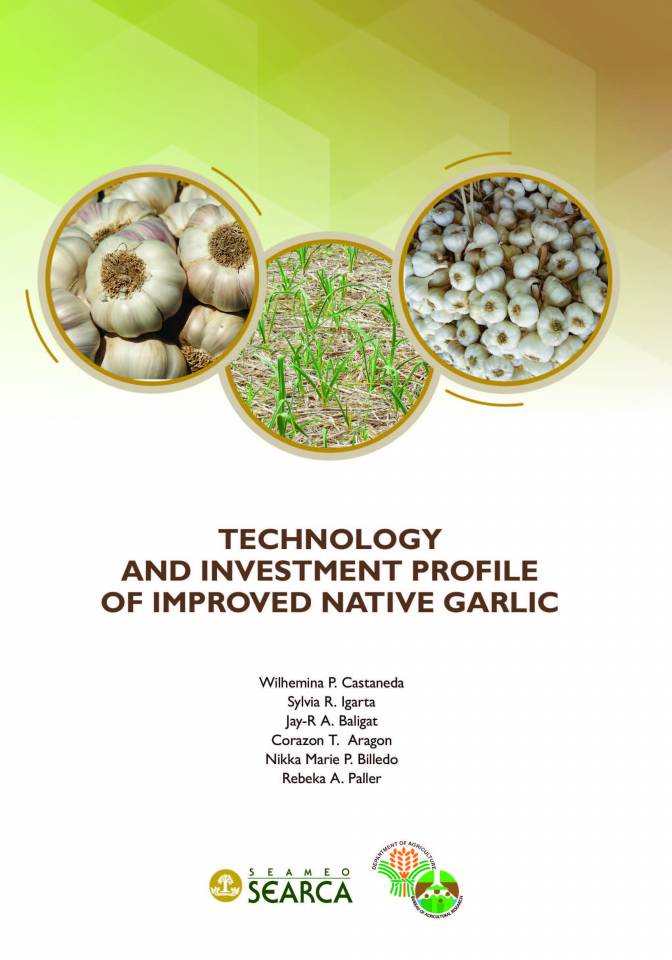The Ilocos Region is the largest garlic-producing region in the Philippines, contributing more than 65% to the country's total production. It has the best comparative advantage in garlic production because of its agroclimatic suitability. However, the region experienced a decline not just in volume of production but also in the area planted and harvested for garlic. The downward trend in productivity may be attributed to low-yielding varieties and high postharvest losses. In addition, the garlic farmers in the region shifted to other high-value crops as a result of low pricing due to a very stiff competition with imported garlic.
 In order to encourage farmers to plant more garlic and increase production in the region, the Department of Agriculture-Regional Field Office I (DA-RFO 1) implemented a project funded by the Department of Agriculture-Bureau of Agricultural Research (DA-BAR) entitled "Enhancing Garlic Production in Ilocos." Through the project, the DA-RFO 1 introduced yield-boosting and enhancing technologies and evaluated the possibility of a two-season cropping of garlic per year. The project introduced the improved native garlic with the aim to improve the garlic industry in the region.
In order to encourage farmers to plant more garlic and increase production in the region, the Department of Agriculture-Regional Field Office I (DA-RFO 1) implemented a project funded by the Department of Agriculture-Bureau of Agricultural Research (DA-BAR) entitled "Enhancing Garlic Production in Ilocos." Through the project, the DA-RFO 1 introduced yield-boosting and enhancing technologies and evaluated the possibility of a two-season cropping of garlic per year. The project introduced the improved native garlic with the aim to improve the garlic industry in the region.
The project and the improved native garlic are the subjects of the study conducted and published by SEARCA entitled "Technology and Investment Profile of Improved Native Garlic" to further assess the commercialization potential of native garlic through a financial viability analysis. Dr. Wilhelmina P. Castañeda, Head of the Agribusiness & Marketing Assistance Division and Chief Agriculturist, Ms. Sylvia R. Igarta, Science Research Assistant I, and Mr. Jay-R A. Baligat, Project Assistant I of the DA-RFO1 implemented the product development and also co-authored in the SEARCA study.
The recommended technologies in improving garlic production consist of the application of Gibberellic Acid (GA3) at 36 and 56 days after planting, direct seeding to facilitate two croppings of garlic, the use of improved varieties, and organic and inorganic application. The project was implemented in Pasaquin and Batac, Ilocos Norte, and in the cities of Batac and Urdaneta, Pangasinan.
With regard to the distribution of native garlic produced in the Ilocos Region, these are brought to markets within the region as well as markets across the country. The domestic demand in recent years for garlic is increasing due to its many uses. It is valued in the food, pharmaceutical, and even in the cosmetics industry. Other intended technology adopters are local farmers who are still using traditional farming practices in garlic production in the Ilocos Region, Southern Tagalog, and Central Luzon regions where garlic is also widely cultivated. The intended users of improved native garlic are household consumers, restaurants, hotels, and pharmaceutical cosmetic companies.
Aside from the technology description, the detailed farm management practices were also indicated in the SEARCA-DA-BAR monograph. More importantly, the profitability analysis for improved native garlic is discussed in the monograph to further strengthen its appeal to potential investors. The authors used costs and return analysis with the following tools: net income, gross margin, and rate of return to capital. Results showed that the improved native garlic is profitable since it has met the parameters for each tool, given the set assumptions. This indicates that it is a feasible investment for interested investors.
SEARCA through its Emerging for Innovation for Growth Department (EIGD) is now actively working to support and promote technology-based innovations among local enterprises in the Philippines as outlined in its 11th Five-Year Plan focused on Accelerating Transformation Through Agricultural Innovation (ATTAIN). For a more detailed discussion on the SEARCA-published monograph on technology of cashew products under the DA-BAR-funded project "Financial Viability and Profitability Analysis of Agricultural Technologies and Enterprises," it may be downloaded for free from the SEARCA website: https://www.searca.org/pubs/monographs?pid=481